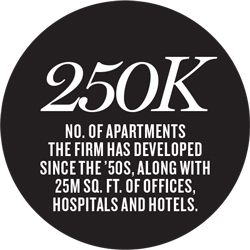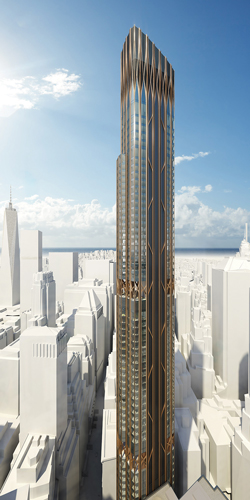Trending
Robert Gladstone’s risky business
The developer’s latest project, at 45 Broad,</br> is his most ambitious and riskiest yet, </br>but if he succeeds it could launch him into a new league

A few months ago, a Chinese investor approached developer Robert Gladstone about getting in on his latest project — a 1,100-foot-tall skinny tower at 45 Broad Street in Lower Manhattan. When Gladstone turned him away, the investor headed to Hermès down the block and spent $75,000 to cheer himself up. At least that’s how Gladstone remembers it.
But despite the developer’s confidence — he said he didn’t need the investor, because he had enough capital to score a construction loan — industry insiders say the project is one of the trickiest in New York. That’s thanks in part to the site’s location across the street from the New York Stock Exchange, a major tourist attraction with extremely tight security.
It’s also the most ambitious project Gladstone has ever attempted — by far. And despite his confidence, he still needs to lock down close to $280 million in financing at a time when the condo market is softening.
The project is not without risk. Several New York City developers told The Real Deal that they passed on the site after determining that it didn’t pencil out as a condo.
But the Madison Equities CEO — a wisecracker with the mischievous grin of a teenager up to no good — said he’s fully aware of the risk and is confident his firm, along with partners Pizzarotti Group and Gemdale Corp., can pull it off. He even slyly predicted that the tower would soon be visible in the sweeping span of Lower Manhattan in the opening credits of one of his favorite shows: Showtime’s “Billions.”
“This building will forever change that picture,” he said during an interview in his Madison Avenue office last month.
That kind of lofty prediction was not always possible for Gladstone.
While he’s been on the development scene for decades, he’s recently been pursuing a string of higher-profile projects. In addition to 45 Broad, he also has the 48-unit condo conversion at 212 Fifth Avenue, where units are listed for upwards of $17 million, and the 16-story ground-up development 10 Sullivan Street in Soho.
But as his profile has risen, so has his notoriety. This year alone, Gladstone has been locked in two high-profile lawsuits — one with Property Markets Group, his partner on the Sullivan Street project, and the other with Town Residential, the firm he fired at 212 Fifth.
 In both cases, he initiated the suits. Sources said he’s also been quietly going toe to toe with Stamford, Connecticut-based commercial firm Building and Land Technology, his equity partner at 212 Fifth, over his refusal to lower prices. (A spokesperson for Gladstone denied that there was any tension between the partners over pricing or anything else.)
In both cases, he initiated the suits. Sources said he’s also been quietly going toe to toe with Stamford, Connecticut-based commercial firm Building and Land Technology, his equity partner at 212 Fifth, over his refusal to lower prices. (A spokesperson for Gladstone denied that there was any tension between the partners over pricing or anything else.)
Still, Gladstone seems to have few qualms about taking on rivals and partners — or about his current risk load. He equated the latter to a science-fiction thriller in which all the characters have clocks strapped to their arms counting down how long they have left to live.
“This one guy gambles down to two seconds,” Gladstone recalled. “We don’t gamble like that, but the risk-taking is big. Everything worthwhile requires risk. If we didn’t take risk, life would be a little bit boring.”
All about that ‘basis’
Madison Equities was launched in the 1960s by Gladstone’s parents, Kenneth and Lucille, who made their initial fortune running a carpentry company in Brooklyn.
Kenneth died in 1999, but Lucille still comes into the office most days. Under their tenure, the company completed projects such as the 371-unit Excelsior, a luxury co-op on East 57th Street, and the Galleria, a 252-unit condo on that same strip.
Gladstone, now 65, joined the family business in 1972 and took the reins in 1992. Over the years, the firm has developed more than 250,000 apartments and over 25 million square feet of offices, hospitals and hotels.
In recent years, the company has moved into the boutique-condo world with high-profile (but small) projects like Chelsea Modern and 57 Irving Place. In the mid-2000s, it also helped assemble a massive site next to the Hearst Communications tower on Eighth Avenue. Madison partnered with Boston Properties on developing the parcel into a 123-unit condo and 350-key hotel.
But during the most recent condo boom, Gladstone began taking on larger deals, such as the Sullivan Street and Fifth Avenue projects.
That buying spree reached a high point in 2015, when the firm snagged the Broad Street site for $86 million, an attractive price for a prime piece of Manhattan dirt that came to less than $300 per buildable square foot. At the time, rival developers were paying as much as $1,200 per square foot for land.
“The basis is a home run,” said JLL’s Dustin Stolly, who has been helping Gladstone line up financing for the project.
The site, between Beaver Street and Exchange Place, had a troubled past.
Developer Kent Swig — and his Hollywood partner Robert De Niro — tried to cobble together funding to build a Nobu Hotel and Residences there in 2006 before losing the property to lender Lehman Brothers Holdings in the wake of the financial crisis.
Then, in 2012, a few years after Lehman went bankrupt, the failed investment bank sold the site to the California State Teachers’ Retirement System for a mere $14 million as part of an $800 million package of U.S. properties.
Gladstone saw a fresh play when CalPERS began shopping it around.

Renderings of 212 Fifth Avenue
Rather than building a hotel on the lower floors — which in his view would have violated zoning restrictions — he settled on offices at the bottom and 206 condo units on top.
Brokers and developers who have seen the site say they worry that condo buyers will be turned off by the tourists outside the stock exchange and by the fact that cars cannot pull up to the building — vehicles are not allow past security barricades.
Compounding matters is that area is filled with tall, view-blocking buildings, including 15 William Street and the Setai at 40 Broad Street. There’s also the added price and complexity of constructing a tall, skinny building — which some said would require charging Billionaires’ Row prices, a near-impossible feat in the area.
“It’s not a deal I’d have done,” said one major developer, who asked to remain anonymous. “It would have been good for rentals, because renters are more forgiving.”
But Gladstone said his basis is low enough that he does not need to score prices anywhere near Billionaires’ Row numbers. In fact, he’s targeting the low end of the luxury residential spectrum and thinks buyers, starved for inventory at that price point, will move fast.
“No one is building for this market at all,” he said. “Most of our units will sell for less than $3 million and 80 percent will sell for less than $4 million. We will even have apartments below $1 million.”
Douglas Elliman Chairman Howard Lorber called the site’s proximity to the stock exchange “a little nit” that could be overcome. “I’ve never seen a site that was perfect,” he said. (Still, sources said Lorber’s Vector Group was slated to invest in the project alongside Madison Equities but exited when the deal was recapitalized last year.)
The project — which began foundation work last month — hasn’t been without its hiccups since Gladstone stepped in.
An offering memorandum for funding obtained by TRD last year showed that the firm predicted it would break ground in September 2016. And Gladstone concedes that there have been challenges.
He’s already in talks with the NYPD’s counterterrorism division and the Downtown Alliance — the business improvement district comprising property owners, commercial tenants, residents and politicians.

45 Broad Street
And there’s a lot to hammer out on top of the usual construction headaches: Not only do all trucks entering the site need to be inspected and scanned, all workers may need background checks before coming through.
Jessica Lappin, president of the Downtown Alliance, called the counterterrorism division “obstinate.”
“It’s not a negotiation,” she said. “They are very firmly grounded in their views. I’ve said to them, ‘Of course safety is the most important thing, but some of the safety things that were put in place 15 years ago pretty hastily should be revisited.”
Gladstone has also been meeting with the MTA to discuss building two elevators to the Broad Street subway station just outside the project in return for the right to build an additional 71,000 square feet of floor area ratio. But that, too, has been more complicated than expected.
Gladstone originally guessed that the two elevators would cost between $2 million and $4 million apiece, but that estimate skyrocketed to $17 million for both.
“It’s a lot more expensive than I thought. We’ve committed to doing it but are in shock over the amount,” he said. “Had we known this from the beginning, we might have had second thoughts.”
Giorgio Cassina, managing director of the foreign division of Gladstone’s Italian partner, Pizzarotti, admitted that the project has been tricky.
“It’s quite expensive, and the logistics are very difficult,” he said. “It is one of the most difficult — maybe the most difficult project — we have.”
Collateral damage
Gladstone said he’s “very close” to landing his full construction loan, and he has several things working in his favor.
For one, his Fifth Avenue project has been a success so far, though sales are still underway.
About 50 percent of the 48 units are already sold and closed, some to big-name buyers such as Charles Kushner, father of senior presidential adviser and son-in-law Jared Kushner, and Texas oil billionaire Ed Bass.
The Sullivan Street deal also generated significant profits for its investors, according to several people familiar with the capital stack.
And he has a solid roster of partners at 45 Broad. In addition to Pizzarotti, the U.S. subsidiary of Gemdale — a blue-chip Chinese developer that constructed and sold 30,000 condos in China in 2013 alone — plowed an additional $92.5 million into the project’s $442 million development price tag. And the project has $55 million of EB-5 financing.
“Bob has a sense of gravitas,” said Michael Krupa, the head of Gemdale in New York. “He can have strong opinions, but I think he’s astute. He’s been doing this for five decades.”
Not everyone agrees with that assessment, though.
While his fans say he’s charismatic and charming, his detractors say he’s egotistical, hot-tempered and prone to angry outbursts.
“He’s a talented developer — truly one of the great talents in New York; that’s the good stuff,” said one of Gladstone’s former colleagues. “It’s his management of what happens after the honeymoon period. He makes things personal. He gets adversarial.”
A spokesman for Gladstone disputed that the developer has a temper, saying, “if it ever was true, it’s not anymore,” adding that he “never raises his voice” and that he’s calmed considerably since surviving throat cancer twice in the 1990s.
Still, Gladstone’s share of adversaries is on the rise.
In March, Gladstone sued PMG and its principal Kevin Maloney over their Sullivan Street project, accusing Maloney of mishandling everything from construction to marketing as well as advancing his own interests at the expense of the partnership.
He said the marketing of the full-floor penthouse was particularly troubling.
“The staging was done not very well,” Gladstone said. “The work was too expensive, and it received no offers. We weren’t getting any bang for the buck. I just felt there was no pizzazz.”
Maloney did not mince words about Gladstone, either.
Maloney, who was heading operations for the project, told TRD at the time, “Why should we not suffer the fate of all other Gladstone partners? I cannot think of a project he was involved in that didn’t include litigation or a bankruptcy.”
He also accused Gladstone of having an outsized ego and a “constant need to control the construction and marketing.”
The partnership had been a tense one for some time, with Maloney booting Gladstone’s wife, Corcoran Group broker Marie-Claire Gladstone, as the exclusive sales agent — a move that did not sit well with the Madison Equities developer.
Maloney also alleged that the project’s lender had him personally guarantee the loan, since it didn’t think Gladstone was “sufficiently creditworthy.”
Emails between Maloney and Gladstone, uncovered as part of their legal battle, show just how desperate the partners were starting to feel about sales.
“We did $4 to $5 million in the past 60 days (ouch) … It’s $45 million off the earlier goal,” Maloney wrote Gladstone in February 2015. “The buyer pool is very thin at the top. God, I pray I’m wrong because that’s where all the profits sit. … The partnership is going to end up holding the bag.”
Gladstone responded that the project is publicly viewed as an “enormous success” and that he was confident he could land a buyer for the penthouse.
Gladstone told TRD that the only offer for the penthouse — which was later divided into two, with Gladstone taking one and Maloney taking the other — came through Marie-Claire.
Maloney, who declined to comment for this story, is still marketing his penthouse. Gladstone sold his for $25 million this year.
“I changed the agent, got rid of all of the staging, brought in my stager, did it at about a third of the cost and got the first offer in two to three weeks,” Gladstone said.
Gladstone thinks he can pull off a similar strategy at 212 Fifth, where he’s partnering with Joseph Sitt’s Thor Equities and Building and Land Technology.
He recently pulled the unfinished $68.5 million penthouse off the market and is planning to relist it once it’s closer to completion.
Meanwhile, Gladstone is going up against Town, which he sued in January for missing sales targets at the project. He replaced the firm with Sotheby’s International Realty.
Gladstone is now suing Town’s Andrew Heiberger for $100 million, alleging that the brokerage CEO defamed him and his company in a bid to “poison public sentiment” against him.
But Heiberger is not backing down. He’s claiming that Madison owns the firm millions of dollars for contracts signed and closed.
Asked whether he thinks all of this litigation will damage his reputation, Gladstone said:
“It already has. I don’t want fame or look for it — in spite of what some people say about me.”
Nobody’s pristine
While Maloney’s assessment of Madison’s bankruptcies might be over the top, the company doesn’t have a perfect track record.
In 2010, in the wake of the financial crisis, sales stalled at 57 Irving Place after the project’s original lender declared bankruptcy. And the following year, an entity in which Madison was a minority partner filed for bankruptcy protection at a Courtyard by Marriott on East 92nd Street.
“There are times you feel like you’re swimming against a tide that is just too powerful and you can’t do anything about it,” Gladstone said. “You say to yourself, how come I’m not smart enough to figure out another game plan? You blame yourself.”
But sources point out that the same can be said for a slew of other New York City developers.
“We know where their skeletons are,” Gemdale’s Krupa said. “No one has been pristine. It’s only a failure if you don’t learn from the mistakes.”
Regardless, Gladstone is already on the hunt for new projects.
He recently tapped the Istanbul-based architecture firm Murat Tabanlioglu to explore the design prospects for two possible new towers, one on 47th Street at Lexington Avenue and another at 118 East 59th Street, sources told TRD.
While a deal to buy the 47th Street site did not pan out, Gladstone confirmed that he’s still eyeing the 59th Street site.
Meanwhile, as Gladstone makes plays for other properties, the fate of 45 Broad hangs in the balance. As one player with knowledge of the project put it: “It’s going to be a long road.”
Correction: In a previous version of this story, TRD incorrectly identified the network on which the television show “Billions” appears. It is Showtime, not HBO.
(To view a list of properties owned by Madison Equities, click here)




